
A randomized trial will soon test whether web-based updates from parents and teachers improve outcomes in ADHD, autism and more.
Eugenia Chan, MD, MPH, is a developmental-behavioral pediatrician and health services researcher in the Division of Developmental Medicine at Boston Children’s Hospital. She runs the Developmental Medicine Center’s ADHD Program and is co-developer of ICISS Health, a web-based disease monitoring and management system.
When I set out with my collaborator Eric Fleegler, MD, MPH, to build a web-based tracking system for children with attention deficit hyperactivity disorder (ADHD), we focused on a single problem—getting parents and teachers to fill out symptom questionnaires in time to help doctors make informed clinical decisions at follow-up visits. We had no inkling of the possibilities that this kind of software platform could hold, or how it might grow in the future. Full story »
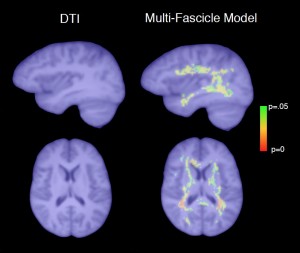
A new MRI computational technology (above right) captures differences in water diffusion in the brain across a population of children with autism as compared with controls. This non-directional, “isotropic” diffusion pattern, not evident with conventional diffusion tensor imaging (DTI), may be an indicator of brain inflammation.
Diffusion tensor imaging (DTI), a form of magnetic resonance imaging, has become popular in neuroscience. By analyzing the direction of water diffusion in the brain, it can reveal the organization of bundles of nerve fibers, or axons, and how they connect—providing insight on conditions such as autism.
But conventional DTI has its limits. For example, when fibers cross, DTI can’t accurately analyze the signal: the different directions of water flow effectively cancel each other out. Given that an estimated 60 to 90 percent of voxels (cubic-millimeter sections of brain tissue) contain more than one fiber bundle, this isn’t a minor problem. In addition, conventional DTI can’t interpret water flow that lacks directionality, such as that within the brain’s abundant glial cells or the freely diffusing water that results from inflammation—so misses part of the story. Full story »
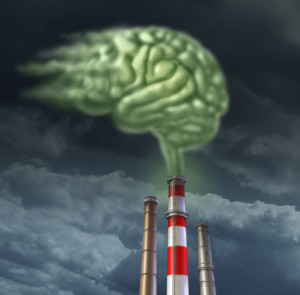 Maitreyi Mazumdar, MD, MPH, practices pediatric neurology at Boston Children’s Hospital. She leads a research program in Bangladesh that studies the effects of the epidemic of arsenic poisoning on neurological outcomes in children.
Maitreyi Mazumdar, MD, MPH, practices pediatric neurology at Boston Children’s Hospital. She leads a research program in Bangladesh that studies the effects of the epidemic of arsenic poisoning on neurological outcomes in children.
Neurodevelopmental disorders, including autism and attention deficit/hyperactivity disorder (ADHD), affect many millions of children and appear to be increasing in frequency worldwide. Improved diagnosis and changes in diagnostic criteria explain a portion of the rise, but not all. In other words, the increase in neurodevelopmental disorders seems to be “real.”
To date, research has mainly invested in finding genetic causes, implicating biological pathways that affect, for example, the formation of synapses and the production of neurotransmitters. Such discoveries improve our understanding of the basic biology of neurodevelopmental disorders and may ultimately lead to new therapies. But genetic variants alone cannot explain the recent rise; if they did, population rates of neurodevelopmental disorders would be expected to stay the same, or even decrease over a 30- to 40-year period, due to affected people likely having fewer children. Instead, reported rates have steadily increased over the past several decades. Something else is going on. Full story »

An 'Information Commons' could better delineate the different faces of ASD by combining objective molecular, biochemical and neurological measures.
Alal Eran, PhD, studies the molecular basis of autism at Boston Children’s Hospital and Harvard Medical School.
Yet another redefinition of autism spectrum disorder (ASD) has stirred up debate. The new Diagnostic and Statistical Manual of Mental Disorders (DSM-5) now collapses four previously distinct conditions—autistic disorder, Asperger syndrome, childhood disintegrative disorder and pervasive developmental disorder not otherwise specified—under one umbrella label of ASD. It also collapses the traditional autistic triad (social deficits, communication impairments and restricted interests/behaviors) into two domains: social/communication deficits and restricted interests/behaviors.
While intended to increase accuracy and utility, the new diagnostic criteria for autism—the fifth revision since 1980—have attracted an unprecedented level of criticism by clinicians, researchers and families. The criteria for membership in DSM categories are much less robust than those for other clinical classification schemes—as evidenced by the rapid change in the DSM over the last 50 years. But more importantly, they are based only on behavioral symptoms. Full story »
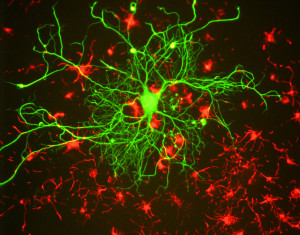
Neuron in tissue culture (Wikipedia creative commons)
Translational neuroscience research has seen a disappointing streak of failed clinical drug trials. While the need for therapeutics that target the nervous system is growing, recent results in diseases like Alzheimer’s and autism have disappointed, and many companies have begun to downsize their R&D investments. Prospects are glum for patients who need new therapies to help manage their disorders.
The frustration is that drug candidates that have shown promise in animal models have not demonstrated efficacy in humans. Mouse models are not proving to be sufficient surrogates for human neurologic disease. Human brains and brain cells are built and function differently, and many neurodevelopmental disorders—hard enough to diagnose in human children—don’t have identifiable behavioral counterparts in mice. As I hear over and over from scientists, there is no such thing as a mouse with autism.
A study, published in Cell Stem Cell this June and conducted by Clifford Woolf, MD, PhD, et al, is among the first to demonstrate the power of an alternative technique: modeling disease in neurons derived from induced pluripotent stem cells (iPS cells). Full story »
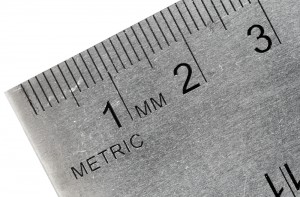 There’s been an explosion of scientific research in autism—from mouse models of genetic syndromes involving autism to culturing neurons from stem cells derived from patients’ skin to tracking EEG patterns in infants whose brothers or sisters have autism.
There’s been an explosion of scientific research in autism—from mouse models of genetic syndromes involving autism to culturing neurons from stem cells derived from patients’ skin to tracking EEG patterns in infants whose brothers or sisters have autism.
So I expected yesterday’s panel on Piecing Together the Autism Puzzle, part of Boston Children’s National Pediatric Innovation Summit, to be about the science. I changed my seat just before it started, so I could better view the slides.
Instead, the conversation turned to the insurance, public health and social justice aspects of autism. Take, for example, the rising incidence of autism, which the CDC places at 1 in 88 (and 1 in 54 in boys). Panelist Ami Klin, PhD, director of the Marcus Autism Center at Children’s Healthcare of Atlanta, noted that between the CDC’s 2002 and 2008 reports on autism, there was close to a 101 percent increase in autism prevalence in Hispanics and a 96 percent increase in blacks.
Thousands of children didn’t suddenly develop autism in a six-year span; rather, more were diagnosed with autism as awareness of the disease increased. Even so, diagnoses often don’t occur until a child is 3 to 5 year old, and only 2.5 percent of diagnostic assessments of autism are using the field’s best standardized tools. While multiple diagnostic tests are being researched—like EEGs or blood tests looking at gene expression—they’re still experimental. Full story »
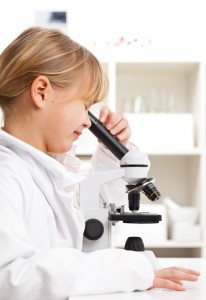 Since our “trends” posts at the top of the year are among our most viewed, Vector took time out this summer to take an interim snapshot of pediatric medicine’s cutting edge. Here we present, in no particular order, our first five picks. Check back next Friday for Part 2. If you want more, there’s still time to register for our National Pediatric Innovation Summit + Awards (September 26-27). The posts will also appear as an article in the fall issue of Children’s Hospitals Today magazine.
Since our “trends” posts at the top of the year are among our most viewed, Vector took time out this summer to take an interim snapshot of pediatric medicine’s cutting edge. Here we present, in no particular order, our first five picks. Check back next Friday for Part 2. If you want more, there’s still time to register for our National Pediatric Innovation Summit + Awards (September 26-27). The posts will also appear as an article in the fall issue of Children’s Hospitals Today magazine.
1. Digital health apps 2.0
The electronic revolution in health care continues. According to recent surveys, more than 90 percent of physicians have smartphones and more than 60 percent are using tablet devices like iPads for professional purposes. Dr. Eric Topol and others think these digital tools are the future of medicine.
Mobile apps keep proliferating, adding more and more features: high-quality image capture, voice-to-text capabilities and gaming techniques to motivate adherence, as well as sensors that gather physiologic data, like glucose levels and heart rate. Consumers are tracking and sharing data themselves, saving time in the clinic and helping physicians monitor their symptoms. Through the much-hyped Google Glass, it won’t be long before doctors can seamlessly call up patient data, look up a drug dosage and get decision support during a clinical visit without using a hand-held device.
One limiting factor in this “Wild West” scenario is the FDA’s ability to keep up with digital advances from a regulatory standpoint. Full story »
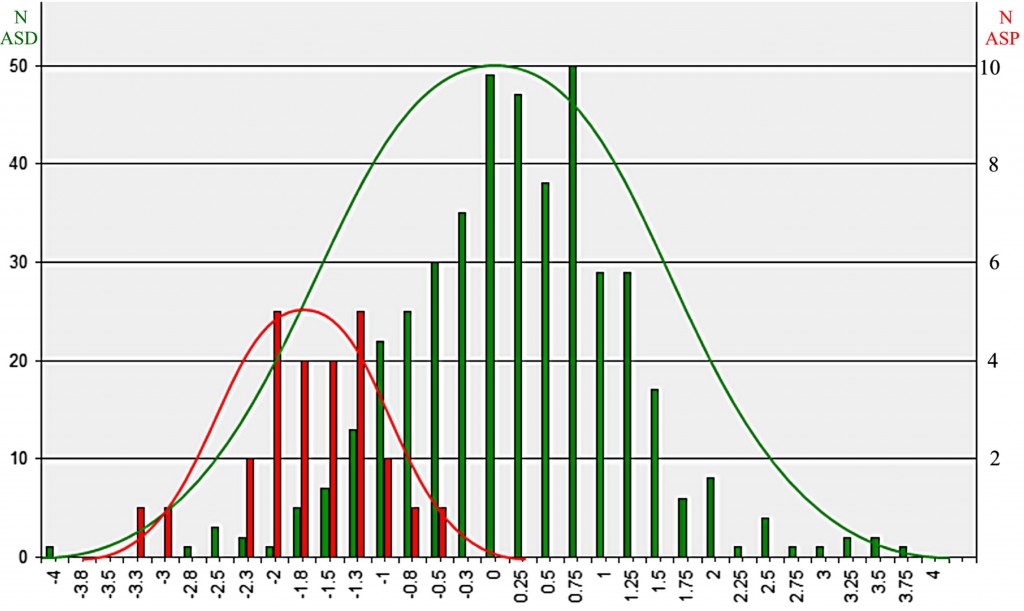
Asperger’s syndrome vs. autism spectrum disorders:
This histogram separates children with Asperger’s (in red) from those with autism spectrum disorders (green) based on EEG coherence variables. Although there is overlap with high-functioning autism, the Asperger’s children clearly form a distinct group. (Courtesy BMC Medicine)
Is it Asperger’s syndrome or is it autism? Since there are no objective diagnostic measures, the diagnosis is often rather squishy, based on how individual clinicians interpret a child’s behavior. According to the
Diagnostic and Statistical Manual, fourth edition (DSM-IV), early problems with language development are an indicator of autism; if there are behavioral symptoms but no early language problems, the child has Asperger’s. However, if the diagnosis is made late, parents’ recall of early language development may be fuzzy.
Under the new DSM-V, published in May, Asperger’s is included under the general “autism spectrum disorders (ASD)” umbrella. This has raised concerns among families who feel their children with Asperger’s have unique needs that won’t be met in classroom programs designed for autism.
Frank Duffy, MD, a neurologist at Boston Children’s Hospital, believes it’s possible to objectively differentiate Asperger’s from ASDs using a new wrinkle on an old technology. Originally trained as an engineer, Duffy is expert at interpreting electroencephalography (EEG) signals—the wiggly lines that represent electrical activity in the brain. Full story »
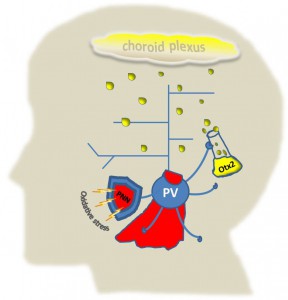 Say you’re a scientist in a movie, and you want to find out what gives a superhero his powers. You’d investigate any special suits he wears, whether he drinks any potions and what they are, right? Real-life scientists are following the same strategy to understand a powerful group of specialized brain cells.
Say you’re a scientist in a movie, and you want to find out what gives a superhero his powers. You’d investigate any special suits he wears, whether he drinks any potions and what they are, right? Real-life scientists are following the same strategy to understand a powerful group of specialized brain cells.
Parvalbumin cells (PV-cells) are a population of inhibitory neurons found throughout the cerebral cortex. While small in number and size, they have the impressive capability to synchronize the electrical activities of other brain cells and orchestrate the timing of critical periods, interludes when the brain is more “plastic” and amenable to rewiring. Abnormalities in these pivotal cells are believed to make plasticity go awry, playing an important role in autism, schizophrenia and other neurodevelopmental disorders.
“The PV-cell is vulnerable in many mental illnesses,” says Takao K. Hensch, PhD, of the F.M. Kirby Neurobiology Center at Boston Children’s Hospital and professor of molecular and cellular biology and neurology at Harvard University. “So if we can find a way to maintain its health and well-being, then we might have a way to treat neurodevelopmental disorders, even later in life.” Full story »















